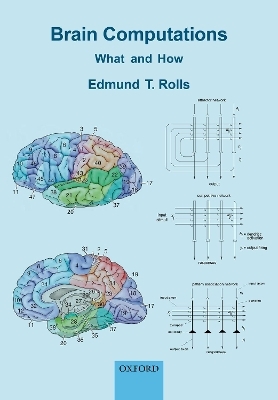
Brain Computations
Oxford University Press (Verlag)
978-0-19-887110-1 (ISBN)
- Lieferbar
- Versandkostenfrei
- Auch auf Rechnung
- Artikel merken
In order to understand how the brain works, it is essential to know what is computed by different brain systems, and how those computations are performed.
Brain Computations: What and How elucidates what is computed in different brain systems and describes current computational approaches and models of how each of these brain systems computes.
This approach has enormous potential for helping us understand ourselves better in health. Potential applications of this understanding are to the treatment of the brain in disease, as well as to artificial intelligence, which will benefit from knowledge of how the brain performs many of its extraordinarily impressive functions.
Pioneering in its approach, Brain Computations: What and How will be of interest to all scientists interested in brain function and how the brain works, whether they are from neuroscience, or from medical sciences including neurology and psychiatry, or from the area of computational science including machine learning and artificial intelligence, or from areas such as theoretical physics.
Professor Edmund T. Rolls performs full-time research at the Oxford Centre for Computational Neuroscience, and at the University of Warwick, and has performed research and teaching for many years as Professor of Experimental Psychology at the University of Oxford, and as Fellow and Tutor of Corpus Christi College, Oxford. His research links computational neuroscience approaches to neurophysiological, human functional neuroimaging and neuropsychological studies in order to provide a fundamental basis for understanding human brain function and its disorders.
1: Introduction
2: The ventral visual system
3: The dorsal visual system
4: The taste and flavour system
5: The olfactory system
6: The somatosensory system
7: The auditory system
8: The temporal cortex
9: The hippocampus, memory, and spatial function
10: The parietal cortex, spatial functions, and navigation
11: The orbitofrontal cortex, amygdala, reward value, and emotion
12: The cingulate cortex
13: The motor cortical areas
14: The basal ganglia
15: Cerebellar cortex
16: The prefrontal cortex
17: Language and syntax in the brain
18: Noise in the cortex, stability, psychiatric disease, and aging
19: Computations by different types of brain, and by artificial neural systems
Appendix A: Introduction to linear algebra for neural networks
Appendix B: Neuronal network models
Appendix C: Information theory, and neuronal encoding
Appendix D: Simulation software for neuronal network models, and information analysis of neuronal encoding
| Erscheinungsdatum | 27.01.2021 |
|---|---|
| Verlagsort | Oxford |
| Sprache | englisch |
| Maße | 180 x 254 mm |
| Gewicht | 1810 g |
| Themenwelt | Geisteswissenschaften ► Psychologie ► Biopsychologie / Neurowissenschaften |
| Geisteswissenschaften ► Psychologie ► Test in der Psychologie | |
| Naturwissenschaften ► Biologie ► Humanbiologie | |
| Naturwissenschaften ► Biologie ► Zoologie | |
| ISBN-10 | 0-19-887110-4 / 0198871104 |
| ISBN-13 | 978-0-19-887110-1 / 9780198871101 |
| Zustand | Neuware |
| Informationen gemäß Produktsicherheitsverordnung (GPSR) | |
| Haben Sie eine Frage zum Produkt? |
aus dem Bereich


